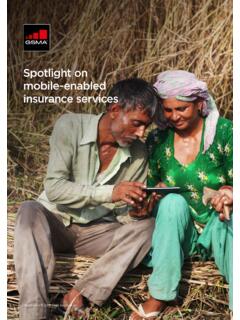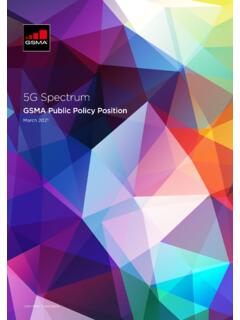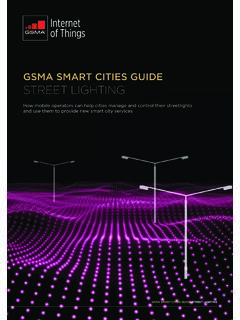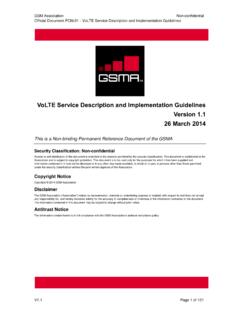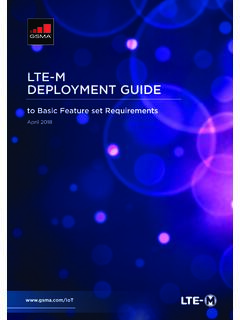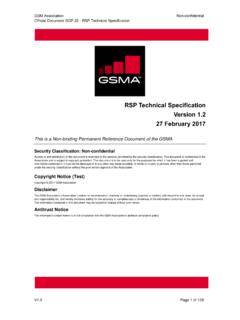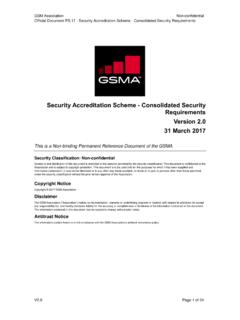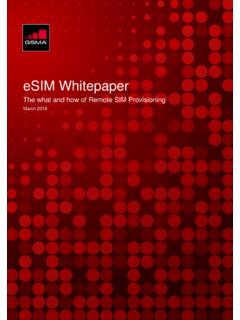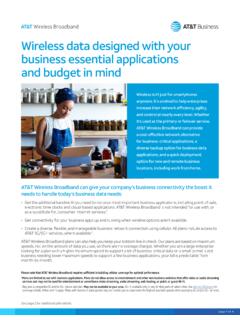Transcription of 5G Implementation Guidelines - GSMA
1 5G Implementation Guidelines July 2019 2 3 OverviewIntroduction 5G is becoming a reality as early adopters have already commercialized data-oriented 5G networks in 2018 and are planning to launch consumer mobile 5G in 2019 and beyond. Whilst early adopters do not necessarily require guidance, there are still majority of the operator community that are yet to launch commercial 5G services . This document intends to provide a checklist for operators that are planning to launch 5G networks in NSA (non-standalone) Option 3 configuration.
2 Scope This document provides technological, spectrum and regulatory considerations in the deployment. This version of the document currently provides detailed Guidelines for Implementation of 5G using Option 3, reflecting the initial launch strategy being adopted by multiple operators. However, as described in GSMA Operator Requirements for 5G Core Connectivity Options there is a need for the industry ecosystem to support all of the 5G core connectivity options (namely Option 2, Option 4, Option 5 and Option 7) in addition to Option 3.
3 As a result, this document will be updated during 2019 to provide Guidelines for all 5G deployment options. Note: The topics listed in this document is not exhaustive and is open to suggestion/contribution by any company. Please contact Acknowledgements Special thanks to the following GSMA Checklist for Non-Standalone 5G Deployment taskforce members for their contribution and review of this document: AT&T Mobility EE Limited Ericsson Huawei Technologies Co. Ltd. Hutchison 3G UK Limited KDDI LG Electronics Inc.
4 MediaTek Inc. Nokia NTT DOCOMO Softbank Corp. Syniverse Technologies, Inc. Telecom Italia SpA Telef nica Telia Finland Oyj United States Cellular Corporation Utimaco TS GmbH Verizon Wireless Vodafone Group ZTE Corporation Abbreviations Term Description 2D 2 Dimensions 3D 3 Dimensions 3 GPP 3rd Generation Partnership Project 5GC 5G Core AMBR Aggregate Maximum Bit Rate AMF Access and Mobility Management Function AN Access Network APN Access Point Name AR Augmented Reality ARD Access Restriction Data 4 Term Description AVP Attribute-Value pairs BEREC The Body of European
5 Regulators for Electronic Communications BPSK Binary Phase Shift Keying BW Bandwidth CA Carrier Aggregation CC Component Carrier CDR Charging Data Record COTS Commercial Off The Shelf CRS Cell-specific Reference Signal CU Centralized Unit CUPS Control and User Plane Separation DC Dual Connectivity DCNR Dual Connectivity with NR DL Downlink DNS Domain Name System DSL Digital Subscriber Line DU Distributed Unit eCPRI Enhanced Common Public Radio Interface eLTE Enhanced LTE eMBB Enhanced Mobile broadband eNB eNode B EN-DC E-UTRAN New Radio Dual Connectivity EPC Evolved Packet Core EPS Evolved Packet System eSRVCC enhanced Single Radio Voice Call Continuity E-UTRAN Evolved-Universal Terrestrial Radio Access FQDN Fully Qualified Domain Name FTTX Fiber To The X FWA Fixed Wireless Access GBR Guaranteed Bit Rate gNB gNode B GW Gateway HARQ Hybrid Automatic Repeat Request HE Home Environment HPLMN Home Public Land Mobile Network HSS Home Subscriber Server IMS IP Multimedia Subsystem Term Description IMT-2020 International Mobile
6 Telecommunication system with a target date set for 2020 IP Internet Protocol IT Information Technology ITU-R International Telecommunication Union Radiocommunication Sector LTE Long Term Evolution MAC Medium Access Control MBR Maximum Bit Rate MCG Master Cell Group ME Mobile Equipment MIMO Multiple-Input Multiple-Output MME Mobility Management Entity mMTC Mobile Machine Type Communications MN Master Node MOCN Multi-Operator Core Network MORAN Multi-Operator Radio Access Network MU-MIMO Multi-user MIMO NAS Non-Access-Stratum NFV Network Function Virtualization NGEN-DC NG-RAN E-UTRA Dual Connectivity NR New Radio NR New Radio NSA Non StandAlone OCS Online Charging System PCRF Policy and Charging Rules Function PDCP Packet Data Convergence Protocol PDN Packet Data Network PGW PDN Gateway POP Point of Presence PRACH Packet Random Access Channel PTP Point to Point PUCCH Physical Uplink Control Channel QAM Quadrature Amplitude Modulation QCI QoS Class Identifier QoS Quality of Service QPSK Quadrature Phase Shift Keying RAN
7 Radio Access Network RAT Radio Access Type 5 Term Description RLC Radio Link Control RoHC Robust Header Compression RRC Radio Resource Control SA StandAlone SAE System Architecture Evolution SCG Secondary Cell Group SC-OFDM Single Carrier Orthogonal Frequency Division Multiplexing SDN Software Defined Networking SGW Serving Gateway SLA Service Level Agreement SMS Short Message Service SMSoIP SMS over IP SN Secondary Node SN Serving Network SRVCC Single Radio Voice Call Continuity SUL Supplementary Uplink SU-MIMO Single-user MIMO TCO Total Cost of Ownership TDD Time Division Duplexing TS Technical Specification UE User Equipment UL Uplink UP User Plane uRLLC Ultra Reliable Low Latency Communications VI Virtual Infrastructure VNF Virtual Network Function Vo5G Voice over 5G VoCS Voice over Circuit Switch VoIMS Voice over IMS VoLTE Voice over LTE VoNR Voice over NR VoWiFi Voice over WiFi VPLMN Visited Public Land Mobile Network VR Virtual Reality WRC World Radiocommunication Conference xDSL x Digital Subscriber Line References
8 Ref Title [1] GSMA PRD , IMS Profile for Voice and SMS [2] BEREC Report on infrastructure sharing , BEREC 2018. [3] GSMA PRD , IMS Roaming and Interworking Guidelines [4] GSMA PRD , 5GS Roaming Guidelines Note: Document will be available in Q4/2019 [5] GSMA PRD , IMS Profile for Voice, Video and SMS over 5G Note: Document will be available in Q1/2020 [6] 3 GPP TS , System Architecture for the 5G System [7] 3 GPP TS , Service requirements for next generation new services and markets [8] 3 GPP TS , 3 GPP System Architecture Evolution (SAE).
9 Security architecture [9] 3 GPP TS , Security architecture and procedures for 5G System [10] GSMA PRD , Diameter interconnect security [11] GSMA Mobile Policy Handbook [12] Migration from Physical to Virtual Network Functions: Best Practices and Lessons Learned 6 Contents Overview .. 3 Introduction ..3 Scope ..3 Acknowledgements ..3 Abbreviations ..3 References ..5 Contents .. 6 1. Commercialisation of 5G .. 8 Fixed Wireless Access ..8 Enhanced Mobile broadband ..8 2. Prerequisite for initial 5G NSA Option 3 launch.
10 11 Introduction .. 11 Spectrum .. 12 Bands earmarked for 5G and their possible utilisation .. 12 Amount of spectrum needed .. 13 4G Radio network updates .. 13 Number of sites needed .. 13 LTE upgrade to support EN-DC (Option 3) .. 14 4G Core network updates .. 14 Option 3/3a/3x Networking Comparison .. 14 Impact Analysis on 4G Core Network Elements .. 15 4G Core Network Upgrading Strategy . 15 5G deployment .. 16 Massive MIMO Selection .. 17 Coverage Enhancement .. 18 Synchronisation Configuration.
